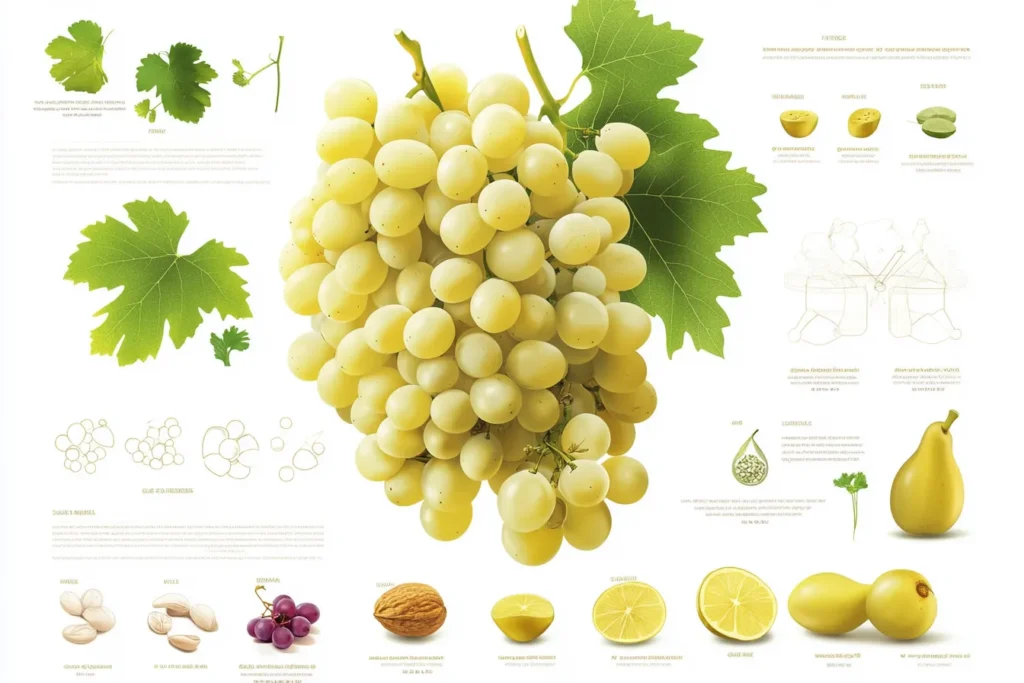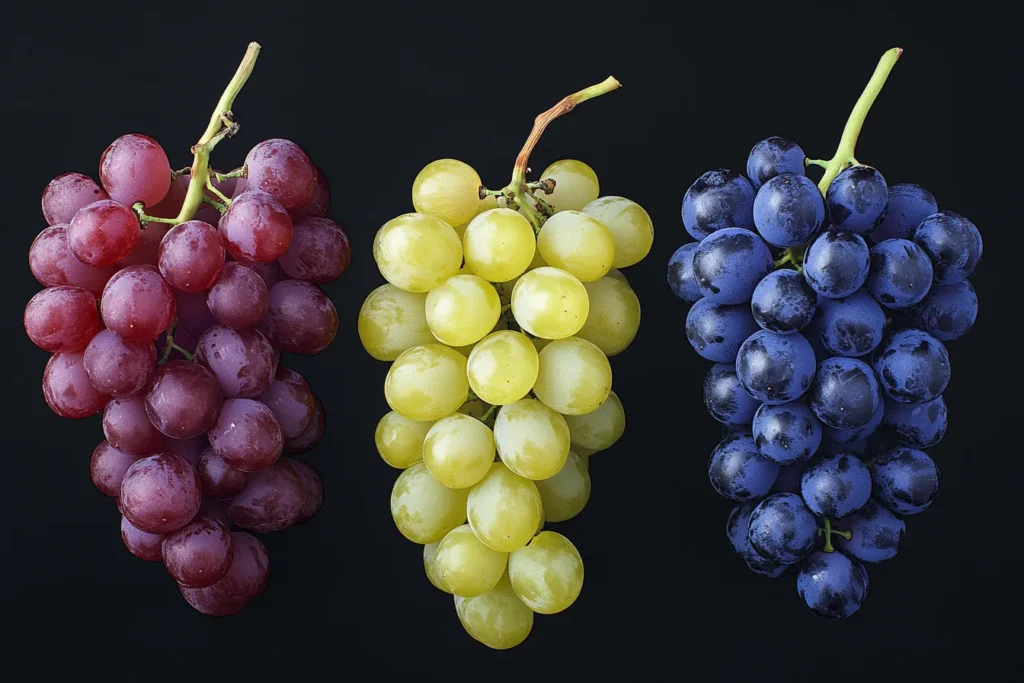Introduction
White grapes have captivated people around the world for centuries. From their deliciously sweet taste to their stunning green-golden color, these fruits are more than just a healthy snack. White grapes hold a wealth of nutrients, antioxidants, and beneficial compounds that support everything from heart health to radiant skin.
In today’s world, white grapes are enjoying renewed popularity thanks to their versatility in culinary uses, their role in white wine production, and the growing trend of planting backyard grapevines. Whether you’re a passionate gardener, a health-conscious foodie, or simply someone who loves their flavor, understanding white grapes can open your eyes to an entire world of benefits.
In this article, we will explore the fascinating history of white grapes, dive deep into their nutritional makeup, showcase their powerful health benefits, and give you expert-level advice on how to grow, harvest, and enjoy these amazing fruits. You will also discover how white grapes compare to their red cousins, learn how to protect them from common pests, and find answers to the most frequently asked questions about them.
So grab a bunch of white grapes, settle in, and let’s uncover everything there is to know about this timeless fruit that continues to shine in the spotlight today!
The Fascinating History of White Grapes
White grapes have a legacy stretching back over 6,000 years, deeply woven into the fabric of human civilization. Early evidence of grape cultivation has been traced to ancient Mesopotamia, Egypt, and the Mediterranean basin, where grapes were valued for their sweetness and their ability to be transformed into wine. White grape varieties were among the first to be selected and cultivated because of their appealing color, juicy pulp, and versatile use in fresh eating, drying, and fermentation..Grape Ice Cream
The Romans, well-known for their innovations in agriculture, refined grape-growing techniques and spread them throughout their vast empire. They developed vineyard systems that maximized yields while ensuring a consistent grape supply for their growing love of wine. White grapes, with their lighter, less tannic character, were often reserved for refined white wines and sweet table consumption.
During the Middle Ages, white grape vines expanded throughout Europe, becoming a symbol of prosperity. Monasteries played a significant role in preserving grape cultivation methods and experimenting with grape breeding to create new varieties with better resistance and sweeter flavors.
In the modern era, white grapes found a new home in North America. Spanish and Italian immigrants brought their knowledge and their grape cuttings to California, which has since become a leading white grape producer globally. Today, California alone grows thousands of acres of white grapes, making them a major export crop and a central part of the American diet..Grape Ice Pops
From the sun-soaked vineyards of Italy to backyard gardens in the United States, white grapes continue to thrive and adapt, proving their timeless appeal. Their enduring popularity stems not only from their luscious flavor but also from the cultural heritage and stories attached to each bunch harvested across centuries.

Nutritional Profile of White Grapes
White grapes are far more than just a sweet treat — they are nutritional powerhouses packed with vitamins, minerals, and health-promoting antioxidants. Let’s break down what makes them such a smart choice for your daily diet.
Vitamins and Minerals in White Grapes
White grapes provide a wealth of important nutrients in every bite. They are rich in vitamin C, a crucial antioxidant that helps support the immune system and collagen production. They also deliver vitamin K, which plays a vital role in healthy blood clotting and bone strength.
In addition, white grapes contain potassium, a mineral that helps regulate blood pressure and maintain proper heart rhythm. There’s also a good amount of copper and manganese, trace minerals that support energy production and help fight free radicals in the body.
Eating a small handful of white grapes can provide a significant boost to your daily vitamin and mineral intake without adding excessive calories.
Antioxidants and Phytochemicals
White grapes shine when it comes to phytochemicals, plant-based compounds that offer serious health benefits. One of the most powerful is resveratrol, a polyphenol often linked to cardiovascular health and anti-aging properties. While resveratrol is more concentrated in red grape skins, white grapes still contain beneficial amounts.
Flavonoids in white grapes act as antioxidants to protect your body from oxidative stress, which is linked to aging and chronic disease. These antioxidants may help lower inflammation, improve circulation, and support the health of your cells.
Moreover, white grapes contain a natural compound called quercetin, which is associated with antihistamine effects and may help reduce allergy symptoms. Another phytochemical, catechin, supports metabolism and may aid in weight management.
Together, these elements make white grapes a guilt-free, nutrient-dense snack choice that goes beyond their refreshing flavor..Trash Can Drink

Health Benefits of White Grapes
White grapes are far more than just a refreshing, sweet fruit. Their natural blend of antioxidants, fiber, vitamins, and phytochemicals offers a broad range of health benefits that make them a powerful ally for overall wellness. Let’s explore exactly how white grapes can boost your health.
Heart Health Advantages
One of the standout benefits of white grapes is their positive impact on heart health. White grapes contain polyphenols, including resveratrol, that have been linked to improved cardiovascular function. These compounds can help dilate blood vessels, promote better circulation, and reduce plaque buildup in the arteries, potentially lowering the risk of heart disease.
Potassium found in white grapes also supports healthy blood pressure by counteracting excess sodium in the diet. Eating grapes regularly, as part of a balanced lifestyle, may help reduce the risk of strokes and high blood pressure.
Furthermore, the soluble fiber in white grapes can help lower LDL cholesterol (commonly known as “bad” cholesterol) levels, keeping your arteries cleaner and healthier. This combination of nutrients makes white grapes a heart-friendly food you can enjoy every day..Cold Brew Iced Tea
Immune System Support
White grapes are loaded with vitamin C, an essential nutrient for strengthening the immune system. Vitamin C helps the body produce white blood cells, which defend against infection. It also acts as a powerful antioxidant, protecting immune cells from damage by free radicals.
The additional antioxidants in white grapes, like flavonoids and quercetin, offer further immune support by reducing inflammation. Chronic inflammation is a root cause of many illnesses, so lowering it naturally through diet is an excellent step for overall wellness.
For seasonal colds or flu prevention, regularly consuming white grapes can be a tasty and proactive choice.
Cancer Prevention Potential
Researchers have been studying grapes for their cancer-fighting properties for decades. White grapes contain a variety of plant compounds — including resveratrol, catechins, and quercetin — that have shown promise in reducing cancer risk by limiting oxidative stress and blocking the growth of certain cancer cells.
Although most of the research focuses on red grapes, white grapes still provide similar bioactive compounds, albeit in slightly different concentrations. Their antioxidant profile helps protect DNA from damage and supports healthy cell growth..Long Island Iced Tea
Incorporating white grapes into your diet, along with other colorful fruits and vegetables, is a smart preventive measure to lower cancer risk and improve your long-term health.
Weight Management and Digestion
If you’re trying to manage your weight, white grapes are an excellent snack. They are naturally low in calories — roughly 60 calories per cup — and high in water content, which promotes feelings of fullness and reduces the likelihood of overeating.
In addition, the fiber in white grapes supports healthy digestion. Fiber keeps the digestive tract moving, helping to prevent constipation and maintain a healthy gut microbiome.
Their natural sweetness can also satisfy sugar cravings in a far healthier way than processed candies or desserts, making white grapes a smart swap for those aiming to cut back on refined sugars.
In short, these nutrient-packed fruits offer a satisfying, refreshing way to keep your digestive system in balance and maintain a healthy weight.

Popular Varieties of White Grapes
White grapes include dozens of beloved varieties, each with its own unique flavor, size, and use. Let’s explore some of the most popular ones grown around the world today.
Thompson Seedless
Thompson Seedless is by far the most famous white grape variety, and for good reason. Its delicate sweetness, thin skin, and lack of seeds make it perfect for fresh snacking, as well as for drying into raisins. Originating in the Middle East centuries ago, Thompson Seedless was brought to California in the 19th century, where it took off in popularity and remains a dominant crop today.
Thompson Seedless grapes grow in tight, greenish-yellow bunches and ripen in late summer. Their reliable yields, disease resistance, and excellent flavor make them a top choice for both commercial growers and home gardeners alike.
Muscat White Grapes
Muscat grapes are known worldwide for their intensely aromatic, floral fragrance and sweet, almost honey-like flavor. They come in a wide range of subvarieties, but the white Muscat is especially prized in Mediterranean countries for dessert wines and fresh eating.
Muscat grapes can sometimes have seeds, but their incredible taste makes them worth the occasional inconvenience. They grow best in warm, dry climates, producing large, juicy berries perfect for both wine and table consumption.
Italia Grapes
Italia grapes are famous for their large, slightly oval shape and their crisp, juicy bite. With a balanced sweetness and mild acidity, they are very popular across Europe and North Africa. These grapes are commonly sold in fresh markets thanks to their sturdy skin, which helps them handle transport and storage well.
Italia grapes ripen later in the season, usually in September, and are also valued for their relatively high yield and adaptability to different soils.
Other Noteworthy Varieties
Beyond these main types, there are dozens of lesser-known but equally delicious white grapes. Perlette, for example, is a smaller, early-ripening grape ideal for home gardeners. Sugraone is another modern, seedless white grape with a crunchy texture and strong resistance to disease, making it popular for table grape production.
Cultivars like Centennial Seedless and Superior Seedless also deserve mention, as they continue to gain ground in commercial vineyards thanks to their flavor and consistent quality.
How to Grow White Grapes Successfully
Cultivating white grapes can be one of the most rewarding gardening projects you undertake. With the right planning and care, you can enjoy homegrown, juicy grapes for years to come. Here’s how to do it:
Choosing the Right Location
White grapevines thrive in full sun, requiring at least 6–8 hours of sunlight daily to develop healthy fruit. A south-facing slope is often the best choice because it improves drainage and air circulation, helping to prevent diseases like powdery mildew.
Avoid planting white grapes in low-lying areas where cold air can settle and damage the vines in winter or early spring.
Soil Preparation and Planting Techniques
Grapevines prefer well-draining soil with a pH between 5.5 and 7.0. Before planting, work compost or well-rotted manure into the soil to boost organic matter and fertility.
Plant dormant bare-root vines in early spring, spacing them about 6–8 feet apart to give them room to grow. It’s essential to install a strong trellis or arbor system at planting time, as grapevines will need training and support throughout their life.
Watering and Feeding
Although grapevines are relatively drought-tolerant once established, they still need consistent watering, especially in the first year. Water deeply every week during dry spells, ensuring the roots penetrate well into the soil.
Apply a balanced fertilizer each spring to encourage healthy shoots and strong fruiting canes. Avoid excessive nitrogen, which can promote leaf growth at the expense of grape clusters.
Training and Pruning White Grape Vines
Proper pruning is critical to grape health and productivity. In the first year, focus on establishing a strong trunk and framework of permanent canes. After that, prune annually in late winter to remove excess growth and encourage fruitful shoots.
Most growers follow a spur pruning or cane pruning system, depending on the grape variety and climate. Always use clean, sharp pruning shears to reduce disease spread.
Harvesting and Storage Tips
White grapes are typically harvested from late summer through early fall. Check that grapes have developed full color and sweetness before picking — taste testing is the best method.
Use sharp clippers to harvest bunches, taking care not to crush or damage them. Store freshly picked grapes unwashed in breathable containers in the fridge, where they can last up to two weeks.

Culinary Uses of White Grapes
White grapes are among the most versatile fruits in the kitchen, prized for their subtle sweetness, firm texture, and refreshing bite. Here’s how people around the world enjoy them:
Fresh Consumption
White grapes are an instant classic when eaten fresh. Their crisp bite and balanced sweetness make them ideal for lunch boxes, picnic baskets, and charcuterie boards. They pair beautifully with cheeses such as Brie, goat cheese, and aged Parmesan, creating a simple but elegant appetizer.
In salads, white grapes provide a burst of sweetness that complements savory greens or crunchy nuts. Because they are seedless or nearly seedless in most cases, they are a perfect grab-and-go snack for kids and adults alike.
Juices, Wines, and Raisins
White grapes are the backbone of many beloved white wines worldwide. They lend a light, floral, and sometimes citrusy profile to wines such as Chardonnay, Sauvignon Blanc, and Riesling.
Beyond wine, white grape juice is a naturally sweet beverage loaded with nutrients and antioxidants. Unlike store-bought juices packed with added sugar, fresh-pressed white grape juice retains the fruit’s original vitamins and minerals.
Raisins made from white grapes, often called golden raisins or sultanas, are another popular product. They are used in baking, cereals, trail mixes, and even savory dishes like couscous, adding a mild sweetness that balances flavors.
Jams, Jellies, and Preserves
If you want to preserve the seasonal bounty, making white grape jelly or jam is a great option. White grape preserves highlight their subtle floral flavor and pair well with buttered toast, croissants, or even roast meats as a glaze.
Their natural pectin content helps jellies set properly, making homemade preserves both easy and delicious. You can even freeze white grapes as a naturally sweet, bite-sized treat for smoothies and desserts.
White Grapes vs. Red Grapes: A Comparison
While white and red grapes share a lot of similarities, they have important differences worth noting, both nutritionally and flavor-wise.
Flavor Differences
White grapes tend to be lighter, milder, and sometimes floral in flavor compared to their red cousins, which often have deeper, berry-like notes and a bit more tannic bite. This makes white grapes more appealing to kids and to people who prefer a softer taste profile.
Nutritional Differences
Both red and white grapes offer plenty of antioxidants, but red grapes typically have more resveratrol, a compound found in darker skins. White grapes, however, tend to have higher levels of flavonoids that support immune health.
Overall, both are excellent health choices. Eating a variety of grape types helps you maximize nutritional benefits and enjoy a wider flavor palette.
Culinary Uses Compared
White grapes are commonly used for white wines, fresh eating, and golden raisins, while red grapes dominate red wine production and dark raisins. In cooking, red grapes sometimes overpower dishes with their more robust flavor, whereas white grapes tend to blend harmoniously in salads, salsas, and desserts.
Common Pests and Diseases Affecting White Grapes
Like all fruit crops, white grapes can be vulnerable to pests and diseases. Understanding what to look for helps keep your vines healthy and productive.
Insect Pests
White grape vines can be attacked by pests such as grape berry moths, leafhoppers, aphids, and Japanese beetles. These insects feed on leaves, shoots, or grape clusters, potentially reducing yield and damaging fruit quality.
Regular monitoring, proper pruning to improve airflow, and using natural predators like ladybugs can help control many pest populations organically.
Fungal Diseases
Fungal diseases are the most common issue for grape growers, especially powdery mildew, downy mildew, and botrytis bunch rot (gray mold). These diseases thrive in humid conditions and can quickly spread through tightly packed vines.
Prevention is key: maintain good spacing between vines, prune properly to increase sunlight and air penetration, and remove any infected plant debris.
Preventive Measures and Organic Controls
Consider using organic fungicides, such as sulfur sprays or neem oil, if you notice signs of mildew or rot. Always water at the soil level, not from above, to keep foliage dry and discourage fungal growth.
Applying mulch around the base of vines can also help suppress weeds and maintain steady soil moisture, supporting a strong, healthy root system.
Frequently Asked Questions
Are white grapes seedless?
Many white grape varieties today, such as Thompson Seedless and Sugraone, are bred to be seedless, making them easier to eat and kid-friendly. However, traditional white grape varieties, like some Muscats, may still have seeds. Always check the variety before planting or buying.
How do you store fresh white grapes?
Fresh white grapes should be stored unwashed in a breathable container or perforated plastic bag inside the refrigerator. Washing them before storage can cause them to spoil faster, so only rinse right before eating. Stored properly, they can last up to two weeks.
Are white grapes safe for diabetics?
Yes, in moderation. White grapes have a moderate glycemic index, meaning they won’t spike blood sugar as dramatically as more processed sweets. However, because they do contain natural sugar, diabetics should limit their portion sizes to about a half-cup per serving.
Can you grow white grapes indoors?
While it’s more challenging, you can grow white grapes in a greenhouse or in large containers indoors if you have sufficient light. You’ll need a strong support structure and plenty of space, as grapes are vigorous climbers. Supplemental grow lights may help in lower-light areas.
Do white grapes contain pesticides?
Conventionally grown grapes are known to carry pesticide residues. It’s best to wash them thoroughly or buy organic white grapes to reduce your exposure. Growing your own grapes at home organically is another safe and healthy option.
What makes white grapes good for wine?
White grapes generally have a lighter, crisper flavor profile with floral and citrus notes, which translates beautifully into refreshing, aromatic white wines. They also contain less tannin than red grapes, making white wines smoother and easier to pair with many foods.
Conclusion
White grapes are truly one of nature’s most delightful gifts. From their sweet, juicy flavor to their incredible health benefits and versatility, they have earned their place in gardens, vineyards, and kitchens around the world. Whether you’re enjoying them fresh, drying them into golden raisins, or crafting a crisp white wine, white grapes bring flavor and nourishment to your table.
By learning about their history, nutritional value, varieties, and growing tips, you can appreciate these fruits even more — and maybe even grow them yourself. As a symbol of abundance and wellness, white grapes remain as relevant and beloved today as they were thousands of years ago. So next time you see a bunch of white grapes, you’ll know they carry a story as rich as their taste.
- Harvard Health: Grapes Nutrition — nutritional information
- California Table Grape Commission — industry facts and varieties

Name: White Grapes (Fresh Snack or Salad Add-In)
Ingredients
Equipment
Method
- Instructions:
- Rinse the white grapes thoroughly in a colander under cold running water.
- Pat dry gently with a clean towel.
- If serving as a snack, place the grapes in a serving bowl.
- If using in a salad, halve the grapes and combine with leafy greens, nuts, and cheese in a salad bowl.
- Toss lightly and serve immediately.

